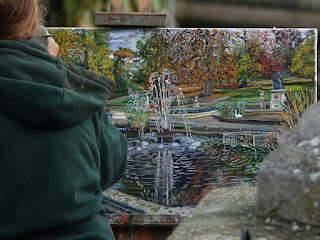Both Little Owls were out. The young one at the Round Pond was looking larger than usual, as he was fluffed up against the slightly chilly breeze.
I managed not to disturb the one at the Speke obelisk. There is a clear limit to how close you can go before he rushes into his hole. It's about 40 yards.
A Starling at the Dell restaurant perched in the hawthorn tree waiting to pounce on a table.
Another at the Lido restaurant had got a bit of bread and flew up to the roof to eat it.
Neil wondered whether Carrion Crows would like dog biscuits. The crows had a hard time pecking them to bits, and ate them with a bad grace as they are used to more luxurious offerings.
A Herring Gull on the Serpentine dived and picked up a stone encrusted with algae, which it pecked briefly and then discarded. They often do this. I'm not sure of the attraction of these things, but perhaps the gull was hoping there would be a snail or other edible creature on the stone.
One of the young Grey Herons played with a stick at the edge of the island.
The boat hire has shut down for the winter and the platform is already colonised by Cormorants.
Two good pictures by Ahmet Amerikali, both taken at the east end of the Serpentine where there are plenty of perch. A Cormorant caught one ...
... and so did a Great Crested Grebe.
The Shoveller drakes have finally made it into full breeding plumage. They are much slower to do this than Mallards or Mandarins, but quicker than Tufted drakes which still don't have completely white sides.
Joan Chatterley photographed a group of Mandarins in Battersea Park. I think we have a few residents on the Long Water, but they spend a lot of time in the bushes and are only seen occasionally.
She also sent a fine picture of a Red Squirrel at Brownsea Island, one of the few places in southern Britain that has not been invaded by Greys.
There were a few more bees in the Rose Garden, all Buff-Tailed Bumblebees. Some browsed on the arbutus flowers ...
... and others on the lavender patch. This one is carrying several mites. Mostly these don't harm the bee and are simply hitching a ride to a hive where they will feed on wax. But there is also the deadly Varroa mite, which sucks out the fat from Honeybees and carries several viruses, and destroys whole colonies of bees.
The railings at the Albert Memorial are being repainted and gilded. It's a long job because they are using real gold leaf, and a lot of it. This has to be done inside a little tent to stop the leaves from blowing away before they have been firmly stuck down. The yellow paint in the foreground is the sticky base layer for the leaf.
Here is a finished section, looking absolutely magnificent.






%202022%201a.jpg)
%202022%201a.jpg)

%202022%201a.jpg)
%202022%201a.jpg)





















%202022%201a.jpg)
%202022%201a.jpg)















%202022%202a.jpg)




